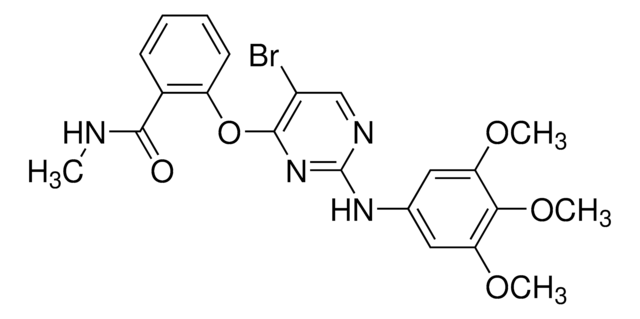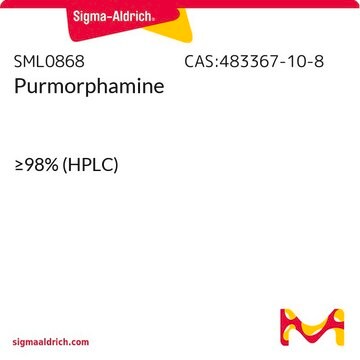P5499
Dorsomorphin
≥98% (HPLC), powder, AMPK inhibitor
Synonym(s):
6-[4-(2-Piperidin-1-ylethoxy)phenyl]-3-pyridin-4-ylpyrazolo[1,5-a]pyrimidine, AMPK Inhibitor, Compound C
About This Item
Recommended Products
product name
Dorsomorphin, ≥98% (HPLC)
Assay
≥98% (HPLC)
form
powder
storage condition
protect from light
color
white to beige
solubility
DMSO: >2 mg/mL (warmed)
storage temp.
2-8°C
SMILES string
C1CCN(CC1)CCOc2ccc(cc2)-c3cnc4c(cnn4c3)-c5ccncc5
InChI
1S/C24H25N5O/c1-2-12-28(13-3-1)14-15-30-22-6-4-19(5-7-22)21-16-26-24-23(17-27-29(24)18-21)20-8-10-25-11-9-20/h4-11,16-18H,1-3,12-15H2
InChI key
XHBVYDAKJHETMP-UHFFFAOYSA-N
General description
Application
- as an inhibitor of adenosine monophosphate-activated protein kinase (AMPK) to find the effects of trans-resveratrol on lipid mobilization in 3T3-L1 (a murine cell line of adipocytes) cells
- as an AMPK inhibitor, to indicate the involvement of AMPK/mTOR (mammalian target of rapamycin) pathway in LRG (liraglutide) -induced autophagy
- in the induction step, employed in in vitro differentiation of Friedreich′s ataxia (FRDA) and induced pluripotent stem cells (iPSCs) to neurospheres and neurons using ES (embryonic stem cell) media
Biochem/physiol Actions
Features and Benefits
Storage Class Code
11 - Combustible Solids
WGK
WGK 3
Personal Protective Equipment
Certificates of Analysis (COA)
Search for Certificates of Analysis (COA) by entering the products Lot/Batch Number. Lot and Batch Numbers can be found on a product’s label following the words ‘Lot’ or ‘Batch’.
Already Own This Product?
Find documentation for the products that you have recently purchased in the Document Library.
Customers Also Viewed
Articles
The AMP-activated protein kinase (AMPK) acts as a sensor of cellular energy status. AMPK exists as heterotrimeric complexes comprising a catalytic α subunit and regulatory β and γ subunits.
The AMP-activated protein kinase (AMPK) acts as a sensor of cellular energy status. AMPK exists as heterotrimeric complexes comprising a catalytic α subunit and regulatory β and γ subunits.
The AMP-activated protein kinase (AMPK) acts as a sensor of cellular energy status. AMPK exists as heterotrimeric complexes comprising a catalytic α subunit and regulatory β and γ subunits.
The AMP-activated protein kinase (AMPK) acts as a sensor of cellular energy status. AMPK exists as heterotrimeric complexes comprising a catalytic α subunit and regulatory β and γ subunits.
Our team of scientists has experience in all areas of research including Life Science, Material Science, Chemical Synthesis, Chromatography, Analytical and many others.
Contact Technical Service
















